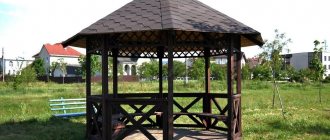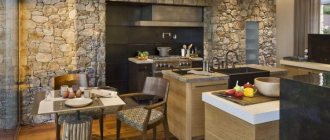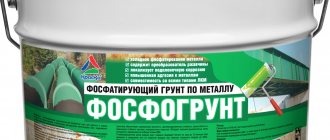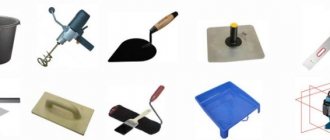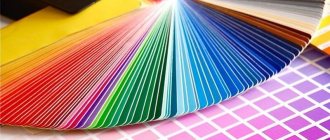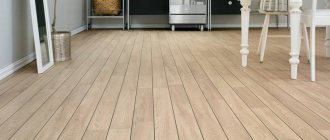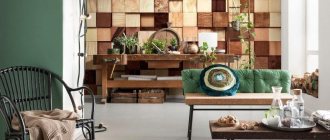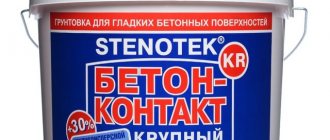Any surface needs protection from external factors. Without it, the material will quickly become unusable.
Despite the fact that the stone is a very strong and durable material, it requires special impregnation that will protect it from moisture, salt and other aggressive components.
Water is the main enemy of stone; time passes and it destroys it. In order for all stone buildings to serve their owner for a long time and maintain their original appearance, the material must be properly cared for.
Types and properties of coatings for stone with a wet effect
Author: Anastasia Isakova · Published 07/16/2018 · Updated 01/27/2018
Impregnation for stone “wet effect” is a unique chemical agent that takes care of the appearance of natural material and also protects it from rapid destruction. Before special impregnations appeared that created the effect of a wet stone, ordinary fat was used. Afterwards, they used products that formed a protective water-repellent film, but it quickly wore off under mechanical influence.
How to make impregnation for stone with your own hands?
Any surface needs protection from external factors. Without it, the material will quickly become unusable.
Despite the fact that the stone is a very strong and durable material, it requires special impregnation that will protect it from moisture, salt and other aggressive components.
Water is the main enemy of stone; time passes and it destroys it. In order for all stone buildings to serve their owner for a long time and maintain their original appearance, the material must be properly cared for.
Polymer varnish for concrete, stone, brick with a “wet stone” effect
- versatility and ease of application
- exceptionally high weather resistance
- provides wear resistance and low abrasion
- protection of concrete from corrosion
- excellent decorative qualities
- has a “wet stone” effect
- semi-gloss
- in 3 hours - small order
- next day - big order
- 3-5 working hours days - for goods on order
- In Moscow within the Moscow Ring Road - from 500 rubles.
- In the Moscow region beyond the Moscow Ring Road - 500 rubles + 20 rubles/km.
- We deliver goods throughout Russia! We deliver free of charge to TK terminals (in Moscow)
More details
- Description
- Application
- Characteristics
- Documentation
- Reviews
Texol is a wear-resistant polymer varnish for protecting concrete, stone, brick, and tiles.
Texol varnish is a one-component, quick-drying varnish based on acrylic copolymer and alkyd resin in a mixture of organic solvents with the addition of targeted additives.
Polymer varnish is recommended for use wherever there is a need to protect mineral materials (concrete, mortar, brick, stone) from corrosion. The varnish is both protective and protective-decorative (has a pronounced “wet stone effect”) with excellent wear resistance and abrasion characteristics.
Texol varnish forms a durable coating on the surface that is resistant to atmospheric and mechanical loads. Polymer varnish has a universal set of properties. Among them, we should highlight such undoubted advantages as the ability to quickly cure and the possibility of application at sub-zero temperatures.
Purpose
Texol polymer varnish is used for protective and decorative finishing of concrete and mosaic floors, paving and facing tiles, natural and artificial stone, decorative paving stones, curbs, bricks and other surfaces exposed to atmospheric influences.
Texol wet stone varnish is also suitable for industrial and warehouse areas for application to concrete floors.
Attention!
- Supplied in lithographed containers!
- The label is equipped with protective elements against counterfeiting!
Mode of application
The varnish is ready for use. If necessary, dilute to working viscosity with a solvent: solvent, butyl acetate, R-Universal.
Apply to a dry, clean surface with a spray, brush or roller in one or two layers.
Temperature conditions for applying varnish: from -20˚С to +35˚С.
Drying time at a temperature of +20˚С is 4 hours .
Consumption
The varnish consumption is 0.25-0.3 kg per 1 sq.m. depending on the type and type of surface.
Precautionary measures
When carrying out interior work, as well as after completion, thoroughly ventilate the room. Use personal protective equipment.
Storage
Do not heat. Keep away from fire. Store the varnish in a tightly closed container, protecting it from heat and direct sunlight. Guaranteed shelf life in original packaging is 6 months from the date of manufacture.
How to work with impregnations
You need to work with hydrophobic impregnations according to the following algorithm:
- Cleaning grounds. This is the first thing you need to start with. All dirt, dust, deposits, etc. are removed. Detergents are used if necessary.
- Next, if necessary, you need to wet the surface (some compounds are applied to dry substrates, while others are applied only to wet substrates).
- If there are defects on the surfaces, they need to be masked using epoxy resin (if the defects are large) or a mixture of cement and sand (for small chips and cracks).
- After masking the defects, you need to give the surfaces time to dry as long as they need, without using additional means to force the event. If the work is carried out, for example, with concrete, then you need to wait at least four weeks.
- Before you start working with impregnations, you need to find out which products work well with which materials. After all, for example, granite surfaces may not be suitable for mixtures that are designed to work with other types of stone. It is recommended to check the final result on a small area of the base before applying it to the entire area.
- It is prohibited to dilute impregnations using foreign mixtures and solutions. They are used in the form in which the manufacturer produces them.
- You can apply impregnation with any convenient tool, but rollers and brushes are most suitable.
- The material is applied to the surface in thin layers, which makes it possible to better absorb it into the substrate and quickly remove excess composition if necessary.
- You need to work either outside in good and clear weather, or in a room that is well ventilated/ventilated.
How to remove rust
In order to remove formed rust from surfaces, you need to use special products that are available in liquid and paste form.
They are made on the basis of organic solvents with anti-corrosion impurities.
The compositions cannot be used on surfaces that are not resistant to acids and chemicals (especially gypsum surfaces).
Impregnations for marble surfaces
Marble surfaces themselves are heterogeneous. There are stains and natural cracks on them. But at the same time, it is more pliable than, for example, granite. And this significantly affects its service life.
Therefore, for marble it is necessary to use special compounds that protect, but at the same time do not leave streaks and do not change the original texture of the material.
Surfaces become resistant to moisture and other negative environmental factors.
Impregnation for stone silicone “Wet stone effect” 10 l
| There are no goods in stock in Rostov-on-Don warehouses |
View prices and availability in other cities
| Krasnodar city | Price: RUB 1,553.38/piece |
| Goods are out of stock in Krasnodar warehouses |
- Description
- Payment and delivery
It is used as a finishing coating for processing natural and artificial stone, red and sand-lime brick, asbestos-cement slabs, slate, tiles, as well as products made of reinforced concrete, foam concrete and fiberglass in order to protect the surface from moisture absorption.
Properties. Virtually odorless, non-toxic, fire and explosion-proof, environmentally friendly material.
Product Availability
- When adding an item to your cart, find out if it is available at a pickup point convenient for you.
- If you need to order more than 100 units of goods, contact our specialists by phone +7(863) 218-53-60
.
Payment for the order
You can pay for your order in the Altus online store in any way convenient for you:
- In cash: upon pickup of goods, or to the courier during delivery;
- By non-cash method: we accept Visa or Mastercard;
- Online banking: we work with Sberbank, Alfabank and Promsvyazbank;
- Online payments through systems: Yandex Money, Webmoney, Visa QIWI Wallet.
Acrylic
Another popular option for both outdoors and indoor decoration. During the production of the material, a substrate of wood shavings or sawdust is used. As a result, if you want products made from such artificial stone to serve well outdoors, you need to order a moisture-resistant backing so that the furniture does not deform. In addition, you should not install acrylic models without a canopy. But, in general, artificial stone TriStone, as well as acrylic from other manufacturers, behaves well in atmospheric conditions.
Types of varnish for wet effect paving slabs, and which one is better?
Wet effect tile varnish gives the coating a rich color, emphasizing the texture of the material. For surface treatment, water-based and solvent-based acrylic varnishes are considered.
Water-based varnish is more often used for interior decoration because it is non-toxic and does not have emissions harmful to the body.
Solvent varnish has harmful emissions and is toxic, but at the same time it has good performance characteristics, which is achieved due to the chemical components in the composition. Therefore, it is recommended to use it for treating street pavement.
The main advantages of processing varnish with a wet effect
Caring for paving slabs is no less important than caring for floor coverings in the house, since timely treatment of paths solves problems such as:
- abrasion;
- wear resistance;
- moisture resistance;
- aesthetics.
A coating treated with varnish that has a “wet effect” property will last longer, receive an additional matte shine and will look wet in dry weather, which will give the design of the paths an unusual look. In addition, tiles with a wet effect will be safer to use due to their anti-slip properties and will retain the natural shade of the material longer.
Impregnation with wet stone effect Elcon Aqwell
Designed to protect mineral surfaces from moisture. Enhances surface color.
Information
Have questions about this product?
Call us, our specialists will answer all your questions
+7
Description
Silicone water repellent Elcon Aqwell
designed to protect finely porous mineral materials (natural stone, facing bricks, concrete) from moisture. Impregnation enhances the color of the treated surface and imparts water-repellent properties.
The water repellent prevents surfaces from getting wet under intense weather conditions, prevents them from cracking, and prevents the appearance of moss, mold, and fungi.
Impregnation penetrates deeply into the pores of the building material ( up to 35 mm
), forming a thin water-repellent film on the walls of the capillaries. The thickness of the film is significantly smaller than the cross-section of the capillary, therefore, as a result of its appearance, the air permeability of materials is not reduced, which is one of the most important sanitary and hygienic requirements for buildings and structures.
How to make your own impregnation for stone?
Despite the fact that the composition can be bought at any hardware store, you can save money and prepare the impregnation at home.
Now you know how to prepare a special impregnation for stone yourself. We wish you pleasant work!
Source
Water repellent as a powerful protection against external influences
When laying tiles for sidewalks, it is important to observe two conditions: proper installation and further treatment with a protective layer. Thus, to create the Wet Stone effect for paving slabs, a water repellent is used. Using a special coating, you can protect the paving surface from weather conditions, as well as various contaminants, for a long time.
Hydrophobization refers to the ability of materials to be saturated (impregnated) with aqueous solutions. Special waterproofing impregnations are used in cases of frequent exposure of the coating to water, precipitation, dew and other wet consistencies.
Water in the form of precipitation, falling on the unprotected surface of paving slabs, destroys the structure of the building material. This happens due to the fact that the aqueous composition is rarely pure. Most often, water is saturated with all sorts of impurities mixed with industrial waste and exhaust gases. Even clean, rainwater can damage the structure of the tile material.
A constantly moistened tile surface becomes favorable soil for the development of mold and moss growth, which leads to subsequent destruction of the material.
A major danger is the appearance of ice on tiles in sub-zero temperatures. The tiles are literally cracking.
You can protect paving slabs from destruction using the following water repellents:
- Tiprom M solution can not only protect the material from ice and moisture, but also create a Wet Stone effect. It is recommended to use a sealer to cover tiles that are located on a drainage path or under a drain. Such places are not constantly exposed to moisture, and the protective layer will help keep the tile material in its original form for a long time. The water repellent is not recommended for use in places where constant accumulation of moisture is possible;
- a water repellent similar to the previous one, called Tiprom K Lux, can be used under various operating conditions.
To create a Wet effect, you can coat paving slabs with other compounds that have water-repellent properties:
- Ceresit CT 10 is a silicone-based water repellent. Already after applying the first protective layer, the Wet Stone effect is noticeable, simultaneously creating an antibacterial film;
- Impregnat Dry is used primarily to protect concrete pavers. You will need to apply 2 layers of the product to achieve the effect stated by the manufacturer;
- VOKA universal product has a strong water-repellent effect. It is enough to apply one layer of solution, which is able to penetrate into the deep structures of the material. Impregnation increases the performance properties of tiles for 10 years.
Regardless of which impregnation option is chosen for processing paving material, the tiles will receive reliable protection from external influences and an increased service life.
Methods for applying water repellents
The protective layer for tiles can be applied in several ways:
- the surface method can be carried out in the form of spraying, watering or applying the solution using a brush or roller. One or more layers of product can be applied. You can start using the sidewalk no earlier than 24 hours after treatment. When the surface dries, it is necessary to ensure such conditions that moisture does not penetrate the treated area;
- The volumetric version of applying a water repellent is carried out during the process of laying tiles. Impregnation is added to the base solution during the production of tile material. The advantage of the volumetric technique is that impregnation prevents moisture from entering the deep structural layers of the material;
- The forced processing technique is performed through holes that are drilled in the tile material. The solution is injected under pressure into the resulting holes, which provides reliable protection for the material during operation.
Technology for creating comprehensive protection
Organizing and carrying out work to create effective comprehensive protection for paving will ensure the presence of a durable protective film that simultaneously performs several important tasks. Its creation is best started before laying the tiles.
First of all, using detergents, it is necessary to thoroughly clean the material from dust and dirt. If the path or platform has already been laid, then we clean the finished surface.
The process of applying water repellent.
Next, you need to pour the hydrophobic composition into a wide container and put the tiles in it for 5-7 minutes, then remove and dry. The water repellent is applied to the laid coating with a roller, paint brush or spray. All subsequent operations are performed only after laying the tiles.
The third stage of work includes painting the paving surface with a special varnish, which allows you to obtain the original “wet stone” effect, emphasizing its color shade.
This treatment is often used for paving stones that have become dull after long-term use. It is recommended to pre-treat the new coating with a hydrophobic solution to increase the moisture resistance and frost resistance of the stone.
To protect the tile joints from the formation of fungus and mold, they must be filled with frost-resistant sealant. This will not only avoid the occurrence of biological formations, but also protect the paving surface from increased penetration of moisture into the bulk base material and subsequent swelling during the cold season.
This set of measures makes it possible for a long time to avoid the accumulation of moisture in the tile material, erosion of seams, fading of tiles, settling of dirt on the surface, and destruction of concrete materials from exposure to alkaline and acidic solutions. High-quality protection makes it possible to achieve a more attractive appearance and durability of sidewalk coverings.
Benefits of use
Many people ask what the advantages of the products are and whether they are worth buying at all. Let's look at why you need to do this. Positive sides:
- The substances will help make the stone hydrophobic; it will not absorb moisture. During operation, marble, gypsum or other stones will not change their properties. On the contrary, the characteristics will only improve.
- Corrosion of cement stones and similar materials is a serious problem. If you protect them with this product, the level of corrosion resistance will increase.
- Chips and cracks will not appear inside the stone.
- After such treatment, the base and foundation of the building will become waterproof. And this property is very necessary for concrete in order to last a long time and not collapse.
- They can improve the appearance of decorative stone, making it expressive, bright and even with the effect of wet stone.
- The compositions are affordable, which allows them to be used for processing.
- They are easy to apply, even without experience in this area.
- The ingredients are harmless.
There are really many advantages. As practice shows, almost all users who decide to use the composition are satisfied with the treatment.
What is stone impregnation?
Hydrophobic impregnation consists of water, which contains a mineral pigment and a binder.
This solution not only protects the stone, it penetrates deep into the material and becomes part of it. The binding component (potassium silicate) creates a chemical reaction during which the stone changes its color.
After this, the material becomes protected from high humidity, sun damage and mold. A transparent film forms on the stone, which covers the entire surface of the stone.
Important! Thanks to the composition of the impregnation, moisture evaporates faster from the surface of the stone and does not get inside, since the water repellent fills all the pores of the material and does not allow water to pass through.
Help chemicals
Both natural and artificial stone are susceptible to corrosion, destruction, moisture and many other external factors. It often develops salt stains or rust stains. Removing them is difficult, but there is a way out. Granite, porcelain stoneware, gypsum and gypsum products can be coated with a special hydrophobic impregnation, sometimes with a silicone base. It will protect surfaces from moisture, rapid destruction and staining.
If stains have already appeared, you can use rust removers. All these substances have a protective and decorative function. For example, treating marble with impregnation makes marble products strong, reliable and durable, and also protects against rust and other stains.
Material properties
Organic and waterborne acrylic varnishes, in general, have similar properties:
- can be used for external and internal work,
- significant strengthening of the surface and structure of brick, paving slabs, concrete, natural and artificial stone, and other coatings based on mineral materials,
- weather protection,
- hydrophobization of the surface and protection against moisture penetration inside,
- decorative appeal: color saturation, shine,
- high degree of adhesion, deep permeability,
- insensitivity to biological, chemical environments,
- insensitivity to UV, temperature changes,
- resistance to mechanical stress, low susceptibility to abrasion,
- extending the service life of structures made of brick, tile, and decorative stone.


